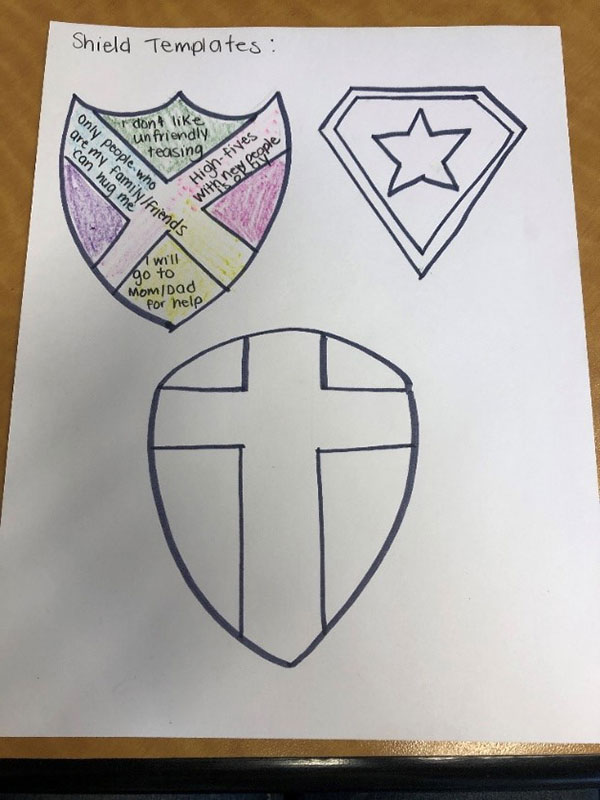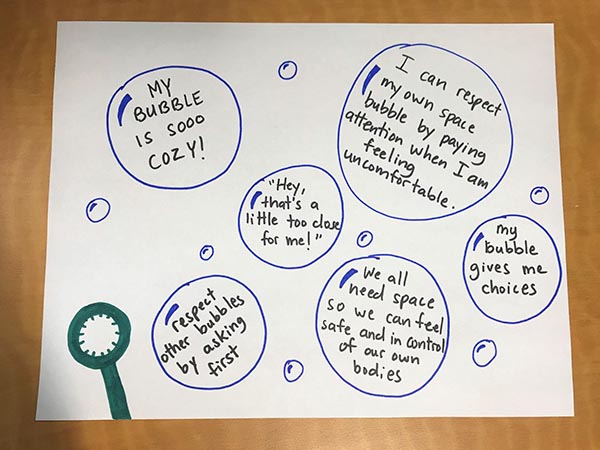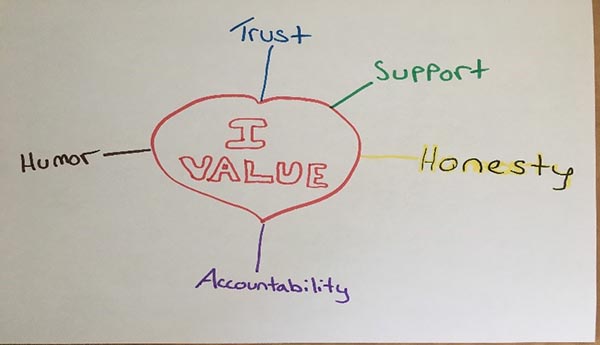Relationships - day 3 - boundaries
These activities can be done alone, but work best with one or more friends on a video chat like Skype, Zoom, Facetime, etc.
Grades K-3
Grades K-3
Mindfulness activity:
Trivia question: What ocean is west of British Columbia?
- Pacific
- Atlantic
- Indian
Mindfulness activity:
- Put your palms together at chest height.
- Push your palms against each other as hard as you can.
- Which muscle gets tired first?
Boundaries shield

Supplies:
- markers or paint
- scissors
- cardboard
Watch the Boundaries Shield video
Directions:
It’s important to identify and express our personal boundaries.
- Cut the shape of a shield out of cardboard.
- Explore what some of your personal boundaries are and write them down on the shield.
- Write some strategies you can use when someone has crossed your boundaries.
- Create a handle out of cardboard and decorate your shield creatively, then play with it.
The Prickly cactus
Directions:
Like a prickly cactus, we can set personal boundaries for ourselves.
- Stand in a room with enough arm length space between you and the next person. One person will call out the following statements.
- If you are uncomfortable with the statement, spin around in your spot with your arms out, being a prickly cactus.
- If you are comfortable with the statement, you can stand still as the cactus.
Some examples of situations are:
- A stranger standing very close to you
- Your best friend gives you a hug
- A random person surprises you and jumps on your back
- Someone giving you a high five when meeting you for the first time?
- Someone giving you a handshake when meeting you for the first time?
- Someone greeting you with a hello when meeting you for the first time?
- Someone from school eating from your plate?
- Someone taking your supplies during a craft without asking?
- A stranger giving you a hug?
Responding to teasing
Supplies:
- paper
- pencil or marker
- scissors
Having a visual strategy allows kids to practice responding to bullies and to unfriendly teasing in a safe, low-stress environment. Discuss the difference between friendly teasing and unfriendly teasing.
Talk about these strategies:
- Ignore and walk away. Or, keep a bored expression and say something like “so?” or “whatever.” Practice holding a natural voice and face when speaking.
- Practice saying: “Please stop because it makes me feel upset.” Setting boundaries when people don’t realize they’ve crossed the line is important. It also makes your friends aware that their words were hurting your feelings.
- Practice saying: “Stop it, I don’t like that.” Practice saying this VERY LOUDLY and confidently!
- Practice saying: “Stop it! Or I’ll tell the teacher (or another caring adult).”
- Practice saying this VERY LOUDLY and confidently!
- Practice walking away and going to tell a caring adult. It’s important to let grown ups know about unfriendly teasing. Grown ups can help and step in.
Craft directions:
- Outline your handprint and cut it out.
- Write down each strategy you’ve practiced or draw a picture to represent each strategy.
- You can use your handprint as a visual reminder of how to respond to unfriendly teasing.
- Decorate your handprint creatively and post it in your room or put it in your note book.
Review questions
Ask your child:
- How does it make you feel when someone crosses one of your boundaries? (Feel)
- Why do you think it’s important to know your boundaries and express them to other people? (Think)
- What are some other strategies you can do to express your boundaries to others? (Act)
Mindfulness trivia answer
The Pacific Ocean is west of British Columbia
Grades 4-6
Grades 4-6
Mindfulness activity
Trivia question: What becomes wetter the more it dries?
Mindfulness activity:
- Get into a comfortable position.
- Take a couple deep breaths in and out.
- Breathing in, say “I see myself as a mountain.”
- Breathing out, say “I feel solid, nothing can move or distract me.”
- Take 10 deep breaths like this.
My bubble
Have you heard of a “personal bubble”? It’s part of your personal space and boundaries. Understanding your personal bubble can help you understand yourself. Your personal bubble protects you and allows you to deal with your emotions without being bothered by things around you.
Supplies:
- paper
- markers, crayons or coloured pencils
Directions:
Draw 6 different bubbles. In each bubble, write a response to the following statements:
- What you say when you feel like someone isn’t respecting your space?
- How do you respect your own bubble space?
- What does it feel like inside your bubble?
- What do you like about your bubble?
- Why do we need a bubble?
- How do you respect other bubbles?

What would you do?
There are different kind of boundaries: physical boundaries, emotional boundaries, personal boundaries, social boundaries, etc. For this activity, you will think about your own boundaries and way you would respond to different scenarios.
Supplies:
- paper
- pen
Directions:
On a piece of paper, write a positive and a negative way to respond to each of these scenarios. Feel free to add your own scenarios. Visualize the situations and practice your response.
- Scenario 1: You have an exam tomorrow and you must study. Your best friend wants to play and asks you to stop studying so you can play with them.
- Scenario 2: You like to have many friends, but your best friend does not like everyone in the classroom. Your best friend tells you that you must stop talking to another friend if you want to keep being friends.
- Scenario 3: A classmate likes to talk to you very closely and touch your shoulder while doing so. Other people in your class seem to like it but you don’t feel comfortable.
Personal values
To set boundaries, you need to know yourself. Think about what makes you uncomfortable or comfortable. For this activity, you will be writing your own personal values. Personal values are guiding principles that are important for you. Some examples of personal values are being able to express yourself, kindness, or forgiveness.
Supplies:
- poster
- construction paper
- markers, crayons or coloured pencils
Directions:
- Write down 3-5 values that are important for you.
- Using colouring items and constructions paper, create a poster. Decorate it with your values.
- Hang your poster in a visible space in your house.
- this will remind you of your core values and guide you when you make decisions.
Review questions
Ask your child:
- When is it hard to say ‘no’ to someone? (Feel)
- How can I share my values with my friends? (Think)
- If I see someone in our house or family going against our values what is something kind that I can say to remind them? (Act)
Mindfulness trivia answer
Answer: A towel
Grades 7+
Grades 7+
Mindfulness activity:
Trivia question: How many bones does the skull (the hard part of your head) have?
- 2
- 5
- 22
Mindfulness activity:
- Sit down however is most comfortable for you.
- Notice the thoughts in your head.
- Let them go without judgement.
- Just say, “Let it go.” Do this for 30 seconds.
Values board

Supplies:
- paper
- pencil
- marker
Directions:
Think about your group of friends. What are the positive and negative influences they have had on you?
Draw three circles: one large, a smaller one inside, and then a smaller one in the very centre.
- In the inner circle, write the names of your closest friends and family – those who make up your safe space.
- In the middle circle, write the names of people you spend time with, but who don’t share your deepest secrets.
- In the outer circle, write the names of people you talk to but don’t feel comfortable sharing too much personal information with. Setting physical, mental, and emotional boundaries can help us maintain healthy relationships.
Day planner
Planning our activities for the day or week can help us keep boundaries and separate school, chores, and leisure activities.
Supplies:
- agenda book or paper
- notebook
- pencil or pen
- calendar
Directions:
- On your paper or agenda write out the hours you will probably be awake from morning till bedtime.
- Schedule in the times you will fulfill your responsibilities such as school work and chores around the house.
- Add in the times you will have for your own leisure. This could be for activities like spending time with friends and family, gaming, or cycling. What hours of the day could these things happen? Who could be the best people to make this time fun?
Review questions
Ask your child:
- How do your values effect your relationships with friends and family? (Feel)
- Why do you think it is difficult to set boundaries with your friends? (Think)
- What are other ways you can set boundaries with your friends? (Act)
Mindfulness trivia answer
The skull is made up of 22 bones that are joined together.

